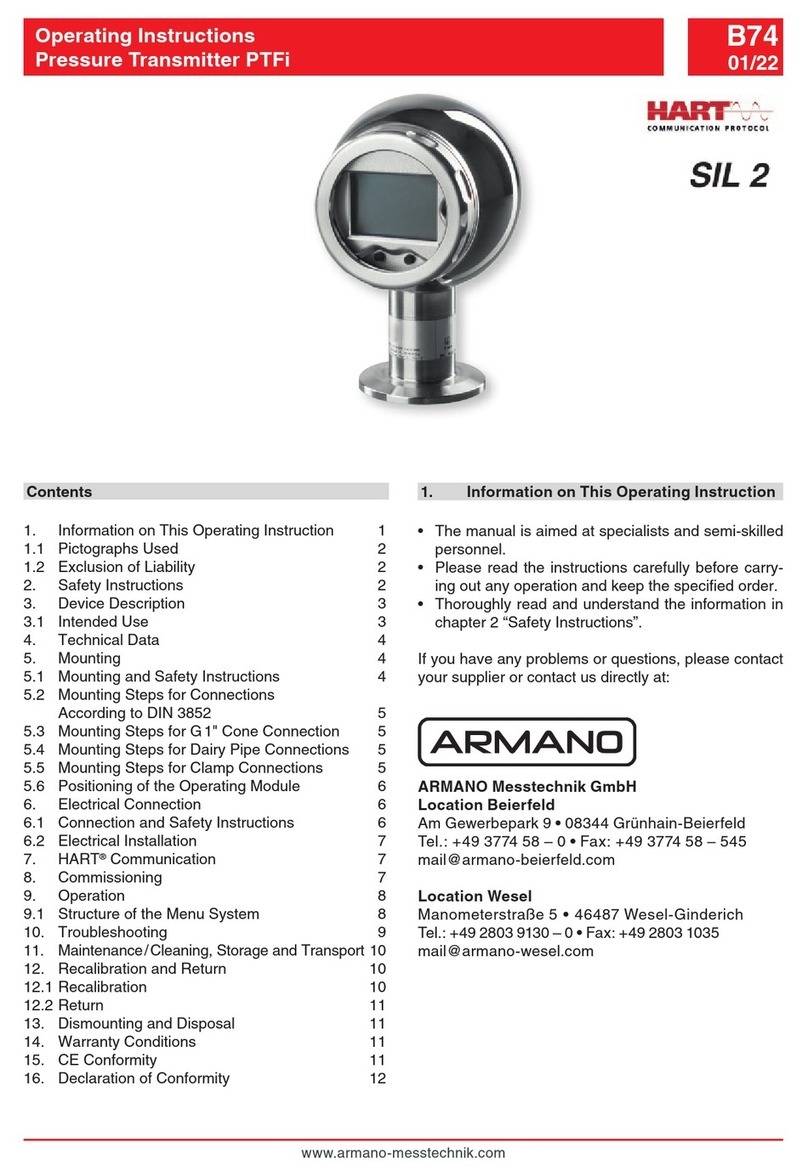
www.armano-messtechnik.com•p. 9 of 32•GB •10/23•B73•B 09-711
Operating Instructions
Process Pressure Transmitters PTPi and PTDi
5.2 Pressure Transmitter Housing
The cases of PTPi, PTDi pressure transmitters are
made of die-cast aluminum or stainless steel and
consist of a body and two screw covers (display and
electrical connection). One of them is equipped with
a glass window. The case has two openings for the
cable entries with thread M 20x1.5 or ⁄" NPT (the
unused opening is closed with blind plugs). The case
consists of two chambers connected by an electrical
bushing. The case is equipped with internal and ex-
ternal ground terminals.
5.3 Main Board with Display
The main board and the display are placed in a poly-
carbonate case. It is inserted into the larger of the
two chambers. The display can be rotated 345° in 15°
steps. In the second chamber is a connection board
with protective devices and EMC lters.
5.4 Sensor Unit
The sensor unit contains a piezoresistive pressure
sensor, which is connected to an analogue/ digi-
tal transmitter via a glass feed-through. The sensor
is separated from the medium by a membrane. The
pressure is transferred to the sensor via a lling liq-
uid. The sensor units have a process connection as
shown in g. 5a, 6a and 7a. The dierential pressure
sensor units have two process connections type P or
C as shown in g. 9.
5.5 Chemical Seal
For the pressure measurement of viscous, chemical-
ly reactive or hot process media, the transmitter can
additionally be equipped with various types of chem-
ical seals.
The chemical seal transmits the process pressure
via an internal liquid lling between the membrane of
the chemical seal and the membrane of the pressure
transmitter. Chemical seals can also be connected to
the process spatially separated from the measuring
instrument. The pressure is then transmitted via cap-
illary line.
6. Place of Installation
6.1 General Recommendations
The intelligent pressure and dierential pressure
transmitters can be installed both indoors and out-
doors. We recommend mounting pressure transmit-
ters for outdoor use in an additional housing or under
a cover.
The place of installation should be selected to allow
access to the device and to protect it against mechan-
ical damage. When planning the installation of the
pressure transmitters and conguring the impulse
lines, the following requirements have to be met:
• The impulse lines should be as short as possible,
with a suciently large cross-section and free of
sharp bends to avoid clogging;
• If the medium is a gas, the pressure transmitters
should be installed above the process opening so
that condensate ows down towards the process.
If the medium is a liquid or if a separating liquid is
used, the pressure transmitters should be installed
below the process opening where the pressure
measurement is carried out.
• The impulse lines should be inclined at least 10 cm /m;
• The levels of the lling uid in the impulse lines
should be the same the dierence should be kept
constant.
• The impulse lines and the valve connection system
should be designed with regard to the measuring
conditions and requirements, such as accessibility
to the transmitter or points for sampling or ushing.
If there is a risk that the pressure trans-
mitter may be damaged by external me-
chanical inuences (in extreme cases,
this may result in the transmitter being
disconnected from the connecting lines,
allowing leakage of the medium), appro-
priate protective measures should be
taken for safety reasons and to avoid
damage, including ying sparks. If the
transmitter cannot be protected prop-
erly, an alternative installation location
should be sought.
Please also regard possible installation errors, which
can lead to measuring errors, e.g. non-tight connec-
tions, sediment clogging in lines that are too small, gas
bubbles in a liquid line or liquid column in a gas line.




























